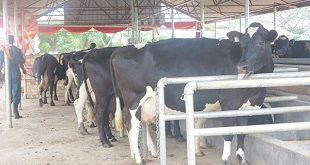
SPECIAL FEATURE | Dr Nathan Mweru | Uganda is endowed with 10 National Parks, 12 Wildlife Reserves, five (05) Community Wildlife Management areas and 13 Wildlife Sanctuaries all under the management of Uganda Wildlife Authority.
Kibale National Park, the Primate Capital of the world with 13 different species of primates and the world’s most popular park for chimpanzee tracking.
Located North of the Equator and East of the Rwenzori Mountains in southwestern Uganda, Kibaale NP is home to the largest wild Eastern chimpanzee population of about 1,500 living in several communities, four of which are habituated for tourism and research purposes.
However, these remaining populations in the wild are facing a range of threats, forcing them into extinction and being listed on the International Union for Conservation and Nature (IUCN) Red list of threatened species as endangered. The biggest threats being habitat loss, poaching and diseases.

There is an increasing human pressure (settlements, agriculture, and development) on the ecosystem due to the increasing human populations. Complicated by the poor living standards of neighboring communities in both protected and un-protected animal habitats, poaching is a reality.
Hunters set traps targeting antelopes and bush pigs for meat. Unfortunately, chimpanzees become accidental victims of these traps leading to loss of body parts and death when not rescued by the Wildlife Veterinarians.
As a wildlife veterinarian and One Health Officer working with the Chimpanzee Health Intervention and Monitoring Program (CHIMP) co-managed by the Kibale Chimpanzee Project (KCP) and the Jane Goodall Institute (JGI) at Kanyawara Research site in close partnership with the Uganda Wildlife Authority (UWA) I set out daily to
- Monitor the health of the Chimpanzees in the Kanyawara community and other mammals for early disease detection and develop mitigation measures.
- Conduct postmortem of deceased primates and other wildlife where need arises.
- Respond to emergencies including snare removal interventions requiring darting.
- Conduct biological sample collection, storage, and analysis among others.

One unfortunate afternoon, I was notified by the field team of KCP of a trapped adult female Chimpanzee, Kabul within the Kanyawara Chimpanzee community. Immediately UWA, and management of KCP/JGI were notified. Since the threat was evidently of human origin, a decision to de-trap the individual was the right one to prevent the adverse effects of the trap and to eventually reduce the excruciating pain Kabul was going through.
Kabul is a dark-faced adult female with an open lower lip as her key identity mark. She is among the last immigrants into the Kanyawara Chimpanzee community.
The team including a Wildlife Veterinarian, and 4 field assistants set out to search and de-trap Kabul as early as 5:30am, searched the habitat and found her at 07.30am in a party of four adult males and females. Kabul was followed until the party split and only two Chimpanzees remained i.e., Zelensky and Kabul both of which are immigrant females.
To calmly handle and save a chimpanzee, the veterinarian must restrain using drugs called tranquilizers loaded in the tranquilizing equipment (CO2 powered Dan-inject dart pistol).
The best shot was taken while Kabul rested on the ground 10 meters away at the muscle of the right shoulder and immediately, fled while screaming and rested on a tree 6 meters above the ground. She was monitored and by the 5th minute full tranquilization was achieved. A tarpaulin was held in place by the field assistants to receive Kabul who freely fell like a ball from the tree.

Team work at play
Immediately, roles were assigned to each team member two guarded the intervention scene, one captured images and notes whereas the fourth assisted the vet during the intervention. The team dressed on Personal Protective Equipment (overalls, double gloving, and facemasks). On examining, the rusted wire trap was tightly held on the right arm around the fingers and cutting through the muscle tissue of the baby finger creating a deep septic wound with extensive swelling. The wire trap was cut using a wire cutter and pliers.
Lucky enough, the joints were intact so the wound was cleaned, and antibiotic shot of gentamicin given intramuscularly. A thorough health check was conducted for all body parts and samples of blood, fecal and swabs taken.
Kabul was finally reversed from tranquilizer and seen turning her head, opening her eyes, sitting up and swinging her arm in confirmation of freedom from the trap.20 minutes later, Kabul was happily able to stride on for food in the forest.
To date, she fully uses her hand normally. THANKS TO THE TEAM.
SAVING ONE CHIMP ANT A TIME.
*****
Dr. Nathan Mweru | Veterinarian and One Health Officer KCP.
 The Independent Uganda: You get the Truth we Pay the Price
The Independent Uganda: You get the Truth we Pay the Price


